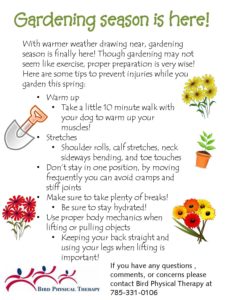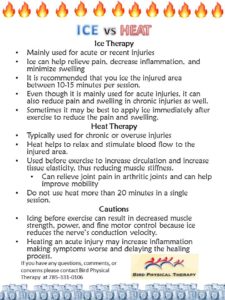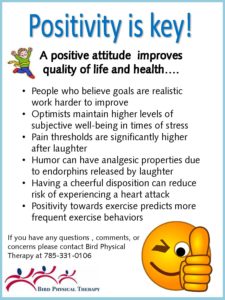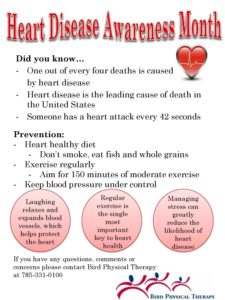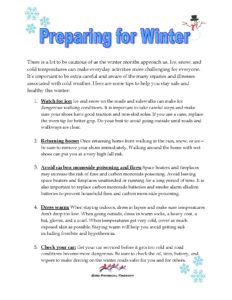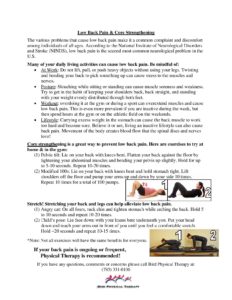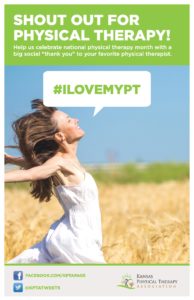Spring has SPRUNG (well, almost…)! As you begin your Spring gardening, browse these helpful tips to prevent those aches and pains that often come along with it. We wish you a happy and healthy Spring!
ICE vs. HEAT
Positivity is key
Heart Disease Awareness Month
Preparing for Winter
Low Back Pain & Core Strengthening
October is Physical Therapy Month!
  October is national Physical Therapy month!
We love providing therapy to all of our patients at Bird Physical Therapy! Help us celebrate PT month by telling us about your favorite physical therapist! Be sure to use #ILOVEMYPT and mention Bird PT!
Did you know?
Kansas has made a recent change to direct access PT? You are no longer required to have a physician’s referral to see a Physical Therapist! If you or someone you know would like to start therapy, save time and money by referring yourself to PT! Give us a call or visit to set up an initial evaluation with one of our therapists and you too can soon love your PT!
Facebook.com/KPTApage
Facebook.com/BirdPhysicalTherapy
Twitter: @KPTAtweets
Twitter: @BirdPTLK
What Does Healthy Skin Mean To You?
What Does Healthy Skin Mean to you ?
Want to know how to keep your skin looking healthy? Starting a regular routine to keep your skin looking young and radiant at a young age is very important. There are several basic ways to start your way towards healthy skin habits!
- Protect your skin from the sun– Apply sun screen with at least SPF 15 and be sure to reapply every 2 hours. Sun rays are the strongest from 10 am to 2 pm; seek shade during those hours. Also, wear protective clothing such as wide brimmed hats or light long sleeve shirts to block harmful rays.
- Don’t Smoke– Smoking leads to wrinkles by decreasing the amount of oxygen and nutrients available to your skin.
- Gentle Measures– Daily cleansing and shaving can damage your skin. Hot water and long showers remove the natural oils and dry out your skin. Also, moisturize your skin daily that is for your skin type.
- Eating Healthy– Eat plenty of fruits, vegetables, whole grains and lean proteins. Research suggests that a diet rich in Vitamin C and low in saturated fats and processed carbohydrates might promote healthier looking skin.
- Manage your Stress– Uncontrolled stress can cause your skin to be more sensitive and lead to skin problems. Scale back your to-do list and spend time doing hobbies you enjoy!
- Skin Checks– Skin cancer is the most common of all cancers. Checking your skin once a month can lead to early detection and improved outcomes. What to look for? Skin growths that increases in size, changes color or texture, has an irregular outline, an open sore that will not heal or is painful.
Visit here for more information:
http://www.mayoclinic.org/healthy-lifestyle/adult-health/in-depth/skin-care/art-20048237
http://www.skincancer.org/skin-cancer-information/early-detection
Raking Leaves
Fall Is In the Air
And Leaves are on the Ground!
   Raking leaves is a great way to burn calories. Harvard Health studied raking exercise for 30 minutes and found that a 150 pound person would lose 149 calories. Ten minutes of raking leaves is such a great activity that it counts toward the exercise recommendation of 2 1/2 hours of weekly exercise set by the Center for Disease Control (CDC).
   Raking leaves can also be detrimental to the body if proper technique isn’t followed. Here are some guidelines to help keep the body healthy when raking leaves:
- Stretch before starting. Raking leaves is just like any other exercise and the muscles must warm up before strenuous activity.
- Do not travel too far while raking leaves. Instead of having one giant pile, try to have several smaller piles throughout the yard.
- When picking up leaves bend at the knees and keep your back straight. When carrying the bag of leaves, the arms should be held in close to the body to minimize stress on the back.
- Wear work gloves! Friction from holding a wooden rake can cause blisters and calluses.
- If you have a large yard do not do too much work at one time. Try dividing the yard and work on raking over a couple of days. (Rome wasn’t built in a day!)
The most important rule to remember is to ENJOY BEING OUTSIDE IN THE COOL CRISP AIR OF FALL.
Heat and Hydration
Warmer weather can mean spending more time outdoors biking, swimming, gardening, and much more. While getting active outside can have its benefits, it should be taken with precaution. Because of the increased heat, the body loses fluids faster and can more rapidly become dehydrated. Being aware of the signs of dehydration, and taking steps to being safe outdoors can help eliminate any dangerous side effects.
Exercise physiologist Jamie Roberts explains how the body is typically warmer than the environment. However, when the summer heat starts to rise, the body responds by sweating, a physiological cooling mechanism. When the body is sweating it starts to lose fluids, which can lead to dehydration if those fluids aren’t being replaced and we aren’t drinking enough water. In serious cases, dehydration can lead to heat exhaustion and heat stroke. Roberts gives these warning signs to be aware of when exercising outside:
• General fatigue and weakness
• Nausea
• Dizziness
• Muscle cramps
• Increase in body temperature
In order to avoid these dangerous side effects, Roberts gives eight easy steps of staying safe in the summer heat.
1. Acclimate yourself. Expose yourself regularly, but slowly.
2. Stay hydrated. Drink about 20 ounces of water before exercise, large gulps every 15-20 minutes during exercise, and at least 8 ounces after exercise.
3. Slow down. Don’t expect to set records in 100 degree heat.
4. Wear light clothing. Lightweight fabric that is of light color is ideal for warm temperatures.
5. Exercise early in the morning or evening. This is the time of day when it is the coolest outside.
6. Think about your previous day’s exercise. If you were not hydrated properly yesterday, this could affect today’s exercise.
7. Find shade. Try not to be in direct sunlight at all times.
8. Consult your doctor. Some medications can intensify the sun’s effect.
For more information, click here.

